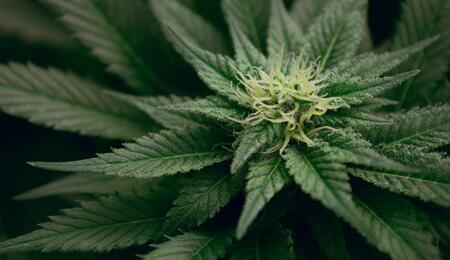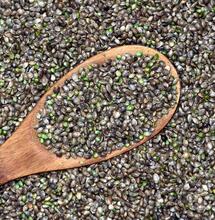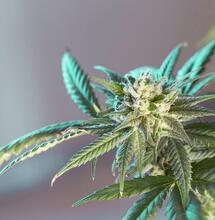Sweets for Your Ladies

The 'sweets' in this article are a treat for your lady Cannabis plants.
Unless your lady happens to be a Cannabis gardener - in which case a nice container of mycorrhizal inoculants, a jar of molasses and a bag of rock phosphate tied with a bow may be an ideal gift - the 'sweets' in this article are a treat for your lady Cannabis plants.
Mycorrhizal fungi are beneficial and assist in nutrient collection and uptake. Adding carbohydrates to a nutrient solution is an old Cannabis gardening trick for boosting garden performance, dating back to at least the 1960s. Mycorrhizae (fungus-roots) are found naturally occurring in healthy, 'live' soil. They are caused by mycorrhiza fungi infecting a plant root, and the two together are what is known as 'mycorrhizae'. Cannabis with well-established mycorrhizae tend to perform better than those that do not.
The relationship between mycorrhizae and Cannabis is a symbiotic one; both organisms benefit from their association with the other. The Cannabis plant provides a carbohydrate source for the fungus, and in return, the fungus assists the plants in nutrient uptake, drought resistance, and blocking their environmental niche from pathogenic fungi. Mycorrhizae collect and process nitrogen, phosphorus and a variety of micronutrients, and pass them to the plant. Of particular use is their ability to increase phosphorus uptake, which dramatically increases in non-infected plants. Most mycorrhiza fall in one of two camps: ecto-mycorrhizal and endo-mycorrhizal. Ectomycorrhizae forms on tree roots. For most other plants, including vegetables and Cannabis, endomycorrhizae is the fungus of choice.
Although commonly already present in healthy soil, mycorrhizae fungus levels can be increased by adding powdered spores (inoculants), available at garden and hydroponic shops. Sterile media and poor soils can be brought from a complete absence of mycorrhizae to abundance with the use of inoculants. If using mycorrhizal inoculants, apply at the beginning of the season to establish the colonies early. Once established, the infected roots should serve as a host to allow the fungus to spread throughout the root system. Plant improvements from inoculant use are particularly pronounced when used in poor or sterile mediums. Mycorrhizae thrive on carbohydrates, which is part of what they receive in payment from the plant in exchange for their services helping the plant thrive. One way to boost beneficial microorganisms, including mycorrhizae, is to feed them with a carbohydrate additive. Carbohydrates (saccharides) are molecules with specific combinations of carbon and water. A subset of carbohydrates are the sugars ending in '-ose'.
For example, table sugar is sucrose (C12H22O11), milk sugar is lactose (also C12H22O11 , but the atoms are arranged differently), blood sugar is glucose (C6H12O6), and so on. Carbohydrates store energy that many life forms can use, people included. The 'sugar rush' from eating a lot of sweets is an effect from over-indulging in sugars. Keep in mind that unwelcome visitors, such as ants, may be enticed to visit if a carbohydrate banquet available, so make sure to clean up any spills promptly. The benefits to adding carbohydrates is mostly indirect; they don't help the plants directly, they feed the beneficial microorganisms that help the plants. These microorganisms use the ready energy available in carbohydrates to thrive and reproduce. Cane syrup, maple syrup, fruit juice, and molasses can all be used as carbohydrate sources. Dilute to two teaspoons (10mL) per gallon (3.8L) of water. Cleanliness is a must, as these may attract insects and leave a sticky residue. Ants may be attracted to the residue, and if hydrated (mixed with water) and allowed to go anaerobic (stale) these may encourage the wrong sort of fungal growth.
Molasses (also known as 'treacle') is a byproduct of sugar refining, and contains not only plenty of carbohydrates to add to your garden, but potassium, nitrogen and iron as well. Many micronutrients are locked in their chelated form and require a chelating agent to unlock them. Molasses acts as a chelating agent (like Humic Acid): it makes micronutrients more readily available for nutrient uptake by the plants. Be careful when purchasing molasses, as prices vary widely. Although all three are useable for gardening purposes, molasses marketed as a plant additive tends to be very expensive; molasses intended for human consumption is moderately priced, and molasses sold as a cattle feed supplement tends to be pretty cheap. Molasses sold for cattle feed is often mixed with a grain to add structure. The addition of grain not only makes the molasses easier to work with, but adds organic material as an additional benefit. Personally, I tend to purchase molasses made for human consumption, as I don't have a large garden; I like it on my pancakes, and in Shoo Fly Pie. Apply at two teaspoons (about 10mL) per gallon of water, or the same amount as per pancake.
To complete the trio, add a good dollop of powdered rock phosphate to the mix. Not only will this provide the mycorrhiza with a supply of phosphorous to supply to the plant, but it can also provide a suitable environment for other beneficial organisms to take up residence. Rock phosphate is available in two forms, 'soft rock', and 'hard rock'. Soft rock phosphate contains a higher amount of immediately available phosphorous, and is usually the choice for container soil enhancement. Hard rock phosphate is better suited to improve a field where plants are to be grown for several years. Mycorrhiza help bring phosphorous and other benefits to Cannabis plants, and carbohydrates help mycorrhiza. Spring is a good time to add inoculants, with a packed carbohydrate lunch and rock phosphorous dessert, to your growing media. Regularly feeding your fungus carbohydrates throughout flowering can have the end result of giving your plants a phosphorous boost. Embrace the fungus among us: feed them, and give them phosphorous to carry. Peace, love and puka shells, Grubbycup



